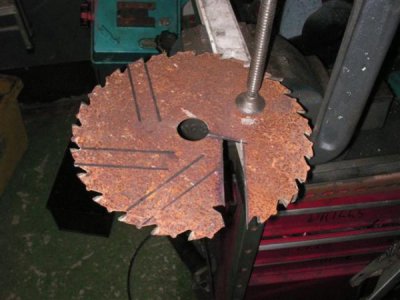-
Welcome back Guest! Did you know you can mentor other members here at H-M? If not, please check out our Relaunch of Hobby Machinist Mentoring Program!
You are using an out of date browser. It may not display this or other websites correctly.
You should upgrade or use an alternative browser.
You should upgrade or use an alternative browser.
Parting Tool Question
- Thread starter Ken S
- Start date
- Joined
- Mar 10, 2016
- Messages
- 55
You could do what many of us do, part it off slightly longer than your target length and face it to the correct length.
olcopper
LOL... Good advice and I've been cutting long all along anyway. Right now I have zero confidence in my ability to part perfectly.
- Joined
- Mar 10, 2016
- Messages
- 55
Carbide tip cut off blade, they actually work good if you sharpen and make them rite
View attachment 127869
Not my pic ,
Hmmm... That's a clever idea. I have plenty of old saw blades stacked up that I never got around to sharpening. I like it!
Thanks
- Joined
- May 4, 2015
- Messages
- 3,583
Your cutter is I bet bending downward or flexing causing the cut your getting. Make sure your tool and compound are not to far to the left of the table lock your table and tighten your Gibs then try your cut I bet it will improve greatly. Takes quite a bit of pressure to do a parting job on small lathes they just don't have the mass to absorb the bending pressure related to the cut. I use to sharpen my blades and make a small relief on top to make the chips curl easier it seemed to help a lot for me.
- Joined
- Feb 7, 2013
- Messages
- 2,489
Another way to use the saw blade carbides is to unsolder them and resolder to a parting tool. Its easy to do
and saves the cutting and can be applied to a stiffer parting device. Its done with a brazing torch,
flux, a bit of silver solder and relatively easy to do.
and saves the cutting and can be applied to a stiffer parting device. Its done with a brazing torch,
flux, a bit of silver solder and relatively easy to do.
- Joined
- Mar 10, 2016
- Messages
- 55
The Aloris #71 just saying.
Yes, that's drool sliding down my chin. Maybe someday
- Joined
- Feb 7, 2013
- Messages
- 2,489
[QUOTE="
flux, a bit of silver solder and relatively easy to do.
Wow, I didn't realize it was only solder holing those on. Thanks[/QUOTE]
It's called silver solder and has a tensile strength of between 40,000 and 70,000 according to Harris Products Group.
Although called solder, it is nothing like the typical plumbing or electronic solders which are a mixture of lead and tin
traditionally. Silver solders have a melting temperature of somewhat over 800 degrees F. Silver solders are usually
an alloy of copper, tin and silver and is available in various mixtures of these metals depending on use and strength needed.


